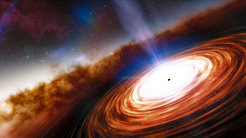eROSITA sees changes in the most powerful quasar
Researchers have observed the X-ray emission of the most luminous quasar seen in the last 9 billion years of cosmic history. Significant changes in the quasar’s emission give a new perspective on the inner workings of quasars and how they interact with their environment. The study was led by Dr Elias Kammoun, a postdoctoral researcher at the Research Institute in Astrophysics and Planetology (IRAP), and Zsofi Igo, a PhD candidate at the Max Planck Institute for Extraterrestrial Physics (MPE).
Hosted by a galaxy 9.6 billion light years away from the Earth, between the constellations of Centaurus and Hydra, the quasar known as SMSS J114447.77-430859.3, or J1144 for short, is extremely powerful. Shining 100,000 billion times brighter than the Sun, J1144 is much closer to Earth than other sources of the same luminosity, allowing astronomers to gain insight into the black hole powering the quasar and its surrounding environment.

Quasars are among the brightest and most distant objects in the known universe, powered by the fall of gas into a supermassive black hole. They can be described as active galactic nuclei (AGN) of very high luminosity that emit vast amounts of electromagnetic radiation; observable in radio, infrared, visible, ultraviolet and X-ray wavelengths. J1144 was initially observed in visible wavelengths in 2022 by the SkyMapper Southern Survey (SMSS).
For this study, researchers combined observations from several observatories in orbit around the Earth: the eROSITA instrument on board the Spectrum-Roentgen-Gamma (SRG) observatory, the ESA XMM-Newton observatory, NASA’s Nuclear Spectroscopic Telescope Array (NuSTAR), and NASA’s Neil Gehrels Swift observatory. eROSITA detected the source during the first five sky scans between 2020 and 2022. “eROSITA is not only a fantastic instrument to discover such rare bright quasars, but also to monitor their variability by repeatedly scanning their X-ray emission every six months,” says author Zsofi Igo. “It will be vital to further our knowledge of accretion physics.”
The team used the data from eROSITA and the other observatories to measure the temperature of the X-rays being emitted from the quasar. They found this temperature to be around 350 million Kelvin, more than 60,000 times the temperature at the surface of the Sun. The team also found that the mass of the black hole at the quasar’s centre is around 10 billion times the mass of the Sun, and the rate at which it is growing to be of the order of 100 solar masses per year.
Further information was revealed by studying how the quasar properties change over time. For example, eROSITA found J1144 to be variable in its brightness over timescales of a year, but interestingly showed little variation in the shape of its energy spectrum during this period. There was also variability detected on a timescale of a few days, which is not usually seen in quasars with black holes as large as the one residing in J1144. Additionally, the observations showed that while a portion of the gas is swallowed by the black hole, some gas is ejected in the form of extremely powerful winds, releasing large amounts of energy into the host galaxy.
“Similar quasars are usually found at much larger distances, so they appear much fainter, and we see them as they were when the Universe was only 2-3 billion years old,” says Dr. Kammoun, lead author of the paper. “J1144 is a very rare source as it is so luminous and much closer to Earth, giving us a unique glimpse of what such powerful quasars look like.”












